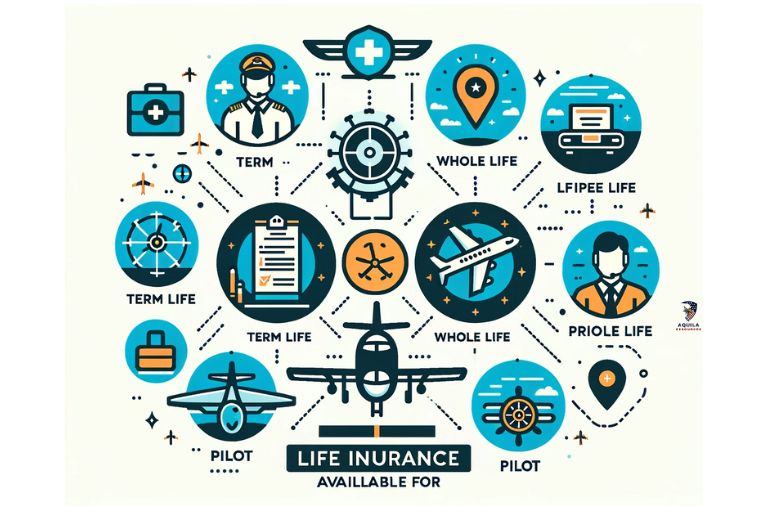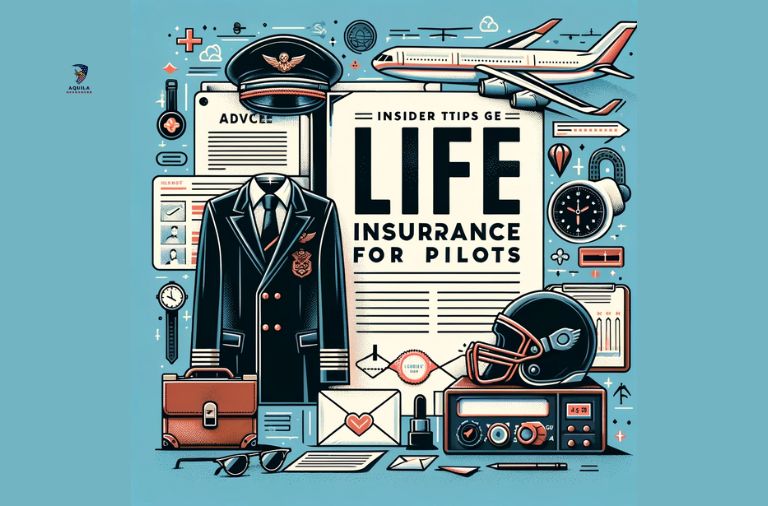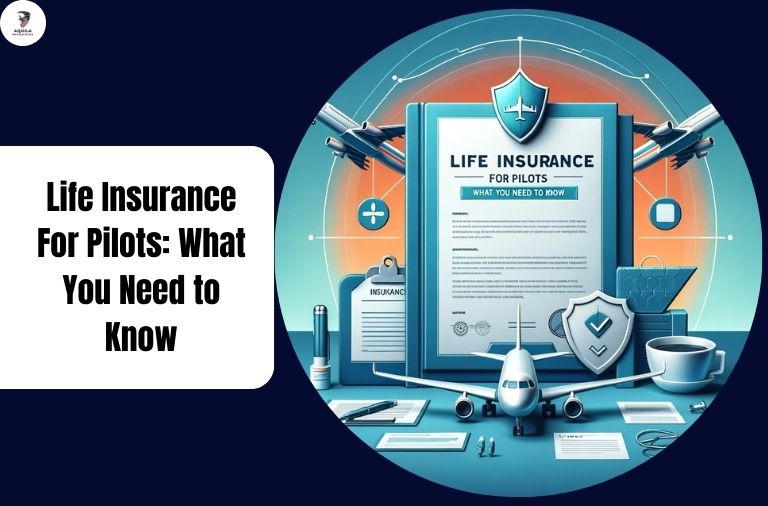Discover comprehensive life insurance for pilots, tailored to meet the unique risks and demands of aviation. Secure your peace of mind with specialized coverage. Protect your legacy today.
It is well known that pilots know how to navigate the skies and manage risks well. You are trained to handle a variety of emergencies and situations, but have you considered safeguarding your loved ones on the ground?
That’s why we’ve put together this comprehensive guide on life insurance for pilots, designed to help you fly above the risks and secure the financial future of those who matter most.
Our guide will explore the specific challenges pilots face when looking for life insurance, including factors such as occupation, flight hours, and aircraft type. Additionally, we will discuss the various types of life insurance policies and products available for the aviation industry, including term life, whole life, and specialized coverage options.
We will help you make an informed decision and find the best pilot life insurance policy to protect your loved ones by following our expert advice and leveraging our extensive knowledge of the insurance landscape.
Let’s start with why pilots need life insurance.
Why Pilot Life Insurance?
Contents
- 1 Why Pilot Life Insurance?
- 2 What is Pilot Life Insurance?
- 3 Types Of Life Insurance Available For Pilots
- 4 Best Life Insurance Companies For Pilots
- 5 Coverage Available in Life Insurance for Pilots
- 6 All-Around Tips When Applying For Life Insurance
- 7 Insider Tips To Get Life Insurance for Pilots
- 8 Key Factor: Finding the Right Insurance Company for Pilots
- 9 Frequently Asked Questions
A life insurance policy is sometimes purchased to protect a family or business. Other times, it’s purchased to maximize your pension or estate. Throughout the article, our insurance specialists can help you determine the best ownership and beneficiary designations for your needs.
When you contact our agency, you will probably speak with a licensed pilot, an agent with extensive life, disability, and long-term care insurance experience.
Burial insurance with no waiting period offers immediate coverage, ensuring peace of mind and financial security for your loved ones’ funeral expenses without delay.
What is Pilot Life Insurance?

We understand that pilots face unique career challenges and risks, which may impact their life insurance needs.
In this section, we will discuss how occupation, flight hours, and aircraft type can influence your premiums and eligibility for pilot life insurance.
Life insurance coverage for pilots varies depending on their occupation. Commercial pilots, for example, may have different coverage requirements than private or recreational pilots.
Commercial pilots may face higher premiums or additional underwriting requirements because of the nature of their jobs. On the other hand, private pilots may have fewer risks associated with their flying activities, resulting in higher rates.
Insurance underwriters use flight hours to indicate a pilot’s skill level and experience. Pilots with more flight hours are considered less risky, resulting in lower premiums. Conversely, those with fewer flight hours may be viewed as higher risk, resulting in higher premiums. Your life insurance application will significantly impact you if you record your flight hours accurately.
A pilot’s life insurance premium and coverage options can be influenced by the type of aircraft you fly, whether a single-engine piston, multi-engine, or turbine aircraft. As a result of the varying risks associated with certain types of aircraft, some insurance providers may have special guidelines or restrictions.
To ensure that your life insurance policy covers you appropriately, you must disclose the type of aircraft you operate.
Other factors such as age, medical history, and lifestyle choices will affect your life insurance eligibility and premiums.
With these factors in mind, you can navigate the complexities of pilot life insurance and find a policy that fits your specific needs at a competitive price.
Types Of Life Insurance Available For Pilots

Pilots can get a variety of insurance policies, so it is crucial to make sure you understand these differences so you can choose the coverage that is right for you.
Private Pilot Life Insurance
Generally, private pilot insurance policies come with higher premiums due to the perceived risk associated with flying privately. However, many insurers offer competitive rates due to the perceived higher risk of flying privately. For instance, if you fly within a specified range of hours per year, the rates may be comparable with non-aviation life insurance policies.
Life Insurance for Student Pilots
Pilots who are still in the process of acquiring the required flight hours and experience might be seen by insurers as a higher risk. Therefore, student pilot life insurance is tailored to consider this, often including additional coverage options and flexibility.
Whole Life Insurance for Pilots
A whole life insurance policy for pilots is an excellent choice for pilots looking for a lifelong solution. It offers a guaranteed death benefit, consistent premiums, and coverage for the policyholder’s entire life. In addition, it has a cash value component that accumulates with time.
Life Insurance for Pilots AOPA
It is also possible for pilots to get life insurance through AOPA (Aircraft Owners and Pilots Association). AOPA works with insurance companies to offer policies that cater to the needs of pilots, taking into account the unique risks and circumstances they face.
Best Life Insurance Companies For Pilots
When you choose the right life insurance company as a pilot, you can secure your family’s financial security. Among the best life insurance companies, we analyzed industry data and third-party ratings from trusted sources like AM Best and J.D. Power.
The best life insurance depends on your health, age, family medical history, budget, the coverage you need, and other factors, but here are a few places to start looking.
Prudential
Term life insurance from Prudential is the best option for pilots. We like Prudential because it offers the best rates for pilots — no aviation exclusion rider needed. An applicant must be 30 years old, have 1,000 hours or five years of flying experience, and have been flying your current aircraft for at least 100 hours to qualify for the best rates.
Pros and Cons of Prudential
| Pros | Cons |
|---|---|
| Diverse Insurance Options | Higher Rates for Some |
| Fewer Consumer Complaints | Below Average Customer Satisfaction |
| Strong Financial Stability | Limited-Term Conversion Options |
| Customizable Policies | Lengthy Underwriting Process |
| Online Applications for Term Life | Few Online Resources |
| Acceptance of Individuals with HIV | Potentially Higher Rates for Health Issues |
| Comprehensive Beneficiary Support | |
| Financial Advisor Advice |
Protective
When you’re a student pilot with little flying experience, Protective is the best life insurance company to work with. With Protective, you can get life insurance while you’re young without paying an extra fee. As a result, your rates will be higher than if you were more experienced.
Pros and Cons of Protective
| Pros | Cons |
|---|---|
| Diverse Insurance Options | Medical Exam Required |
| Multiple Insurance Riders | Online Quotes Not Widely Accessible |
| High Coverage Limits | Not Ideal for Tobacco Users |
| Competitive Rates | Below Average Customer Satisfaction |
| Long-term Policy Options (Up to 40 Years) | |
| Strong Financial Stability (A+ AM Best Rating) | |
| Accelerated Underwriting Option Available | |
| Responds Actively to Customer Complaints | |
| Wide Range of Coverage Amounts |
Legal & General America
The most affordable life insurance rates are offered by Legal & General America, also known as Banner Life and William Penn in some states. You can get the best rates for life insurance for general aviation pilots, but it’s not necessary.
With 100 hours of solo flying experience or less than 250 hours annually, you can still qualify for Legal & General America’s Standard rates – the third-best risk category.
Pros and Cons of Legal & General America
| Pros | Cons |
|---|---|
| Strong Financial Ratings | Limited Product Catalogue |
| Riders for Policy Customization | Some Mixed Customer Feedback |
| Flexible Term Life Insurance Options | No Guaranteed Acceptance for Term Life |
| High Customer Satisfaction | Requires Contact for Permanent Life Quotes |
| Competitive Term Life Premiums | |
| Good Range of Coverage Amounts | |
| Excellent Customer Service Ratings | |
| Fast Claims Processing | |
| Universal Life with Variable Coverage |
Pacific Life
We recommend Pacific Life for life insurance with no medical exam. Although flying can sometimes disqualify hobby pilots from no-medical-exam policies, Pacific Life still allows hobby pilots to apply for coverage with no medical exam at all — as long as they answer questions about their flying history and pay an additional fee.
Pros and Cons of Pacific Life
| Pros | Cons |
|---|---|
| Fewer Complaints Than Average | Select Policies Not Available in New York |
| Variety of Term and Permanent Policies | No Online Quotes Available |
| Many Riders to Choose From | No Official Claims Response Time Frame |
| Strong Financial Stability | Many Negative Customer Reviews |
| Good Options for People with Health Conditions | Some Customer Service Options Missing |
The best dental insurance with no waiting period in 2024 offers immediate coverage, catering to urgent dental needs with a wide network of providers and comprehensive benefits.
Coverage Available in Life Insurance for Pilots
Term Life Insurance
You can protect your family’s finances after you die by buying term life insurance. Term life policies are easy to manage, last only for a limited period, and are cheaper than whole life insurance. For a healthy 30-year-old, a 20-year term life insurance policy with a payout of $500,00 would cost less than $30 monthly.
Whole Life Insurance
Life insurance policies with a whole life component typically have a higher premium than term life policies, but their premiums remain the same for their entire lives. A cash value can be accessed for financial needs, such as education expenses or retirement income, by taking loans or withdrawing funds.
Universal Life Insurance for Pilots
Term life insurance and cash value are combined to create universal life insurance, a flexible permanent life insurance option. The policyholder can adjust the premiums and death benefits over time, giving them more control over their coverage requirements.
All-Around Tips When Applying For Life Insurance
How to Have a Better Medical Exam
Insurance companies generally require a medical exam on any policy worth $100,000 or more. It consists of a blood draw, a urine sample, and a series of questions regarding your medical history. The insurance company may also require an EKG when applying for larger policies or at an older age. The insurance company should pay for the exam; the nurse will visit your home or office to perform it.
Here are some good measures to take before your next insurance medical exam:
Certain health conditions cannot be masked, but here are some recommendations to obtain the best results.
- Ensure you get a good night’s sleep the night before your exam. Avoid drinking for at least eight hours before the test.
- For at least an hour before your exam, don’t smoke or chew tobacco.
- It would help to avoid caffeine at least an hour before the test, including coffee, tea, and cola.
- Limit salt intake and high-cholesterol food 24 hours before your exam.
- Don’t engage in strenuous physical activities 24 hours before the exam.
Disclose Your Complete Medical History to The Insurance Company
You do not need to conceal your medical history to qualify for a better insurance rate. Provide complete records of your medical history to save time during the underwriting process.
Medical Information Bureaus (MIB), a clearinghouse of medical information that insurers share or the results of your insurance medical exam, can help insurance companies track your medical records. Moreover, your results and records are sent to the MIB whenever you apply for life insurance and take a medical exam.
If you have any medical history, it is best to provide your doctor’s contact information so the insurer can request your records. If you have a significant history, the insurance company often needs to receive an APS (Attending Phywhotement) from the doctor who has treated you. If you are fortunate enough not to have a medical history, please state None on the application if you are one of the lucky ones. Do not list a doctor to list one. Otherwise, the insurance company may spend time searching for your medical history from the physician you listed.
Low-down on Smoking Rates
Insurance companies see two types of people: non-smokers and smokers. If you smoke just one cigarette a week, your insurance premiums will be the same as those for someone who smokes a pack a day! If you smoke more than 20 cigarettes a day, your premiums will be even higher. Insurance companies believe that smoking increases the risk of premature death through research and medical studies. The premium rates for smokers can easily be two to three times higher than those for non-smokers.
What about non-cigarette tobacco use?
Non-cigarette tobacco use is generally treated differently by insurance companies compared to smoking cigarettes. Non-cigarette tobacco users can qualify for non-smoker premium classes, which offer them substantial savings over cigarette rates. Non-cigarette tobacco users who are eligible for non-smoker premium classes include:
- Cigar
- Pipe
- Chewing Tobacco
What if I used to smoke? How long until I can qualify for a non-smoker category?
Those who smoke cigarettes must be smoke-free for at least one year before qualifying for a standard non-smoking rate; for a preferred non-smoking rate, it takes two years. One year of no-tobacco use for most non-cigarette tobacco users qualifies them for a preferred non-smoking rate.
The More You Weigh, The More You Pay
The cost of life insurance can be very high if you are overweight. Insurance companies base premium classes on a person’s height and weight. Some guidelines suggest what weight is appropriate for men and women according to height.
According to a study by the American Medical Association, being overweight is associated with health problems. You will be dropped to the next appropriate premium class if you are over a certain height and weight limit. In a recent study published in the Journal of the American Medical Association, excess weight contributes to 280,000 deaths annually in the United States. Insurance companies concluded that overweight individuals are more likely to have other health issues, such as high cholesterol or high blood pressure. You will still be charged more if you are 10 pounds over the insurance company’s ideal height/weight chart.
Below is a chart showing the desirable weights for males and females published by the American Medical Association:
| Height | Small Frame | Medium Frame | Large Frame | ||||
|---|---|---|---|---|---|---|---|
| Men | Women | Men | Women | Men | Women | Men | Women |
| 5’1″ | 4’9″ | 123-129 | 99-108 | 126-136 | 106-118 | 133-145 | 115-128 |
| 5’2″ | 4’10” | 125-131 | 100-110 | 128-138 | 108-120 | 135-148 | 117-131 |
| 5’3″ | 4’11” | 127-133 | 101-112 | 130-140 | 110-123 | 137-151 | 119-134 |
| 5’4″ | 5’0″ | 129-135 | 103-115 | 132-143 | 112-126 | 139-155 | 121-137 |
| 5’5″ | 5’1″ | 131-137 | 105-118 | 134-146 | 115-129 | 141-149 | 125-140 |
| 5’6″ | 5’2″ | 133-140 | 108-121 | 137-149 | 118-132 | 144-163 | 128-144 |
| 5’7″ | 5’3″ | 135-143 | 111-124 | 140-152 | 121-135 | 147-167 | 131-148 |
| 5’8″ | 5’4″ | 137-146 | 114-127 | 143-155 | 124-138 | 150-171 | 134-152 |
| 5’9″ | 5’5″ | 139-149 | 117-130 | 146-158 | 127-141 | 153-175 | 137-156 |
| 5’10” | 5’6″ | 141-152 | 120-133 | 149-161 | 130-144 | 156-179 | 140-160 |
| 5’11” | 5’7″ | 144-155 | 123-136 | 152-165 | 133-147 | 159-183 | 143-164 |
| 6’0″ | 5’8″ | 147-159 | 126-139 | 155-169 | 136-150 | 163-187 | 146-167 |
| 6’1″ | 5’9″ | 150-163 | 129-142 | 159-173 | 139-153 | 167-192 | 149-170 |
| 6’2″ | 5’10” | 153-167 | 132-145 | 162-177 | 142-156 | 171-197 | 152-173 |
| 6’3″ | 5’11” | 157-171 | 135-148 | 166-182 | 145-159 | 176-202 | 155-176 |
Insider Tips To Get Life Insurance for Pilots

There are a few essential tips and considerations pilots need to keep in mind as they look for the perfect life insurance policy.
Pilots must stay informed and follow these recommendations to make informed decisions that meet their unique needs.
Transparency
It’s important to be transparent about your flight activities and profession when applying for life insurance, including your flying experience, type of aircraft, and nature of flights. This way, you can avoid potential complications and obtain the right coverage.
Keep Informed
Make sure you stay up to date with aviation industry developments. Regularly monitoring aviation industry updates and trends can help pilots stay on top of changes affecting their life insurance coverage. Stay current on industry developments, safety advancements, and other relevant news.
Review Your Policy Periodically
Life insurance policies should be reviewed periodically to ensure they remain up-to-date and meet your current needs as your life circumstances and aviation career change. In addition to maintaining adequate coverage, periodic evaluations help you adapt to changes in your professional or personal life.
Work With an Experienced Insurance Agent
When it comes to pilot life insurance, partnering with an insurance agent specializing in aviation policies can be invaluable. You can benefit from their expertise in finding the right coverage, negotiating favorable terms, and navigating the underwriting process.
Consider Adding Riders to Your Policy
If you meet the conditions for a waiver of premium or accelerated death benefit, you may benefit from adding this option to your life insurance policy. Talk to your insurance agent about these options.
Maintain a Healthy Lifestyle
Prioritizing their health and well-being can help pilots get better life insurance rates and eligibility. You can improve your insurability and lower your premium rates by exercising regularly, maintaining a healthy diet, and undergoing routine medical checkups.
It takes careful research, planning, and collaboration with industry professionals to find a pilot’s right life insurance policy. Pilots can protect their loved ones and safeguard their financial future by heeding these tips and considerations when navigating the life insurance landscape.
Key Factor: Finding the Right Insurance Company for Pilots
Selecting the best life insurance company is crucial in safeguarding your financial future as a pilot.
As you embark on this journey, you must consider various factors to ensure you partner with a company that understands the unique challenges and requirements of the aviation industry.
In this section, we’ll guide you in finding the right insurance company to meet your needs using aviation industry terms, LSI terms, and the semantically related entities discussed earlier.
Research and Compare Companies
For a better understanding of coverage options, premium rates, term duration, and underwriting guidelines, it is vital to research and compare different life insurance companies. The insurers specializing in aviation or with extensive experience working with pilots will better understand the industry’s unique risks and challenges.
Financial Stability
Choosing an insurance company with a strong financial foundation is crucial since it shows the ability of the insurer to fulfill its obligations and pay out claims when needed. The ratings of independent agencies such as A.M. Best, Standard & Poor’s, and Moody’s can be used to evaluate a company’s financial health.
Reputation and Customer Services
It is crucial to consider a company’s reputation and customer service quality. Consider insurers with positive customer reviews and testimonials. Also, consider their responsiveness and willingness to answer questions and address concerns. Investing in insurance companies that value customers and prioritize their needs will make them a better long-term partner.
Tailored Coverage for Pilots
Pilots should choose a company that offers tailored life insurance plans. Depending on your flying career, you can adjust coverage levels or purchase policies with aviation-specific provisions, such as flight coverage. SAI is better equipped to provide coverage that suits your unique needs because it understands the intricacies of the aviation industry.
Seek Expert Advice
Obtain advice from professionals, such as financial advisors. By providing insights and recommendations based on your specific circumstances and needs, they can assist you in making informed decisions regarding your life insurance coverage.
Following these guidelines will make choosing the right life insurance provider that fits your unique needs and circumstances easier. You should remember that choosing the right insurer to get life insurance for pilots is more than just finding the lowest rates; it’s also about getting comprehensive coverage that offers peace of mind and safeguards your financial future.
Frequently Asked Questions
Can I Get Life Insurance As a Pilot?
Pilots can buy life insurance, but they are considered a high-risk profession, so not all companies offer policies. However, there are still a few that do.
At What Age Should a Pilot Retire?
While reauthorizing the Federal Aviation Administration this year, Congress is considering legislation raising the retirement age for commercial pilots from 65 to 67.
What Kind of Insurance Do Pilots Get?
Private and commercial pilots typically receive general liability insurance from their carriers as it covers situations that can result in significant expenses.
Do Pilots Get Free Insurance?
Even though it sounds appealing, pilots do not usually receive free insurance. Some airlines include life insurance in their comprehensive employee benefits package. For pilots, especially private and student pilots, additional coverage is usually necessary to protect their loved ones.
What Types of Coverage Are Available in Life Insurance for Pilots?
Life insurance for pilots typically includes specialized coverage options to address the unique risks associated with aviation. These can range from basic term life policies to more comprehensive plans covering accidental death and disability, often with provisions for flight-related incidents. It’s important for pilots to consult with insurance experts to find the right balance of coverage and cost.






![Cheapest Low Income Car Insurance Texas In 2024 [Updated] Low Income Car Insurance Texas](https://www.aquilaresources.com/wp-content/uploads/2024/02/Low-Income-Car-Insurance-Texas.jpg)








Add Comment